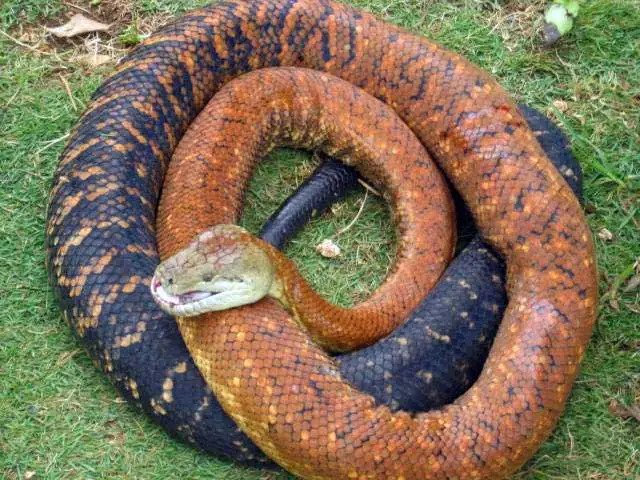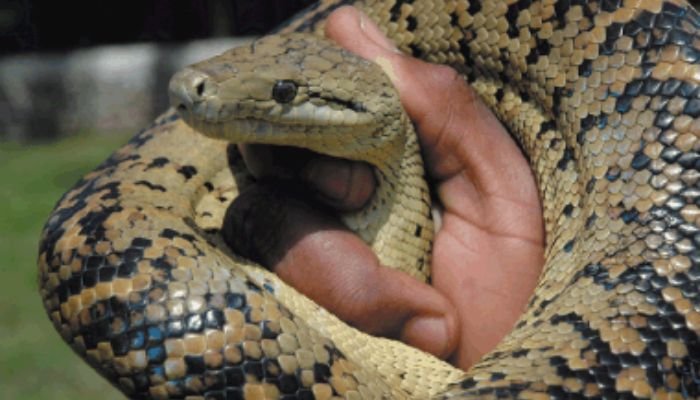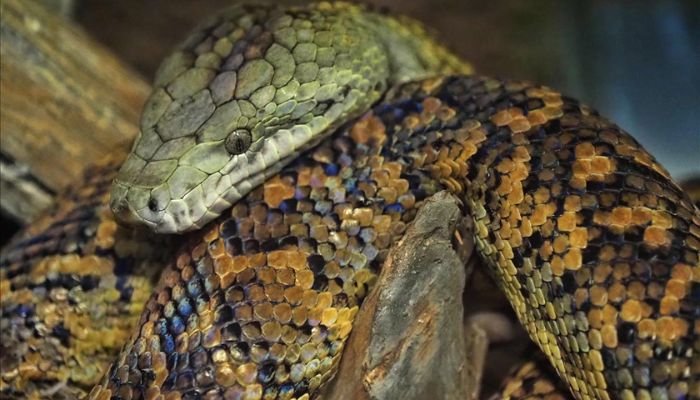
The Jamaican Boa is a species of nonvenomous snake native to Jamaica. It is occasionally known as the Yellow Snake or Yellow Boa. It is a striking reptile due to its characteristic yellow coloration. Because they can readily climb trees, Jamaican boas are typically arboreal, forest-dwelling animals. They forage opportunistically, feeding primarily on small mammals, birds, and reptiles. They have a significant impact on the ecosystem by moderating rodent populations despite their size.. Here are Jamaican boa Guide on Food, Habitat, Size, Lifespan & Predators below-
Jamaican boa Stats in Table format
The stats are given below for Jamaican boa
| Reptiles List | Jamaican boa |
|---|---|
| Family | Boidae |
| Type | Snake |
| Size | Medium to Large |
| Length | Jamaican boa: Up to 4-6 feet (1.2-1.8 meters) |
| Color | Jamaican boa: Usually has a brown or gray coloration with lighter or darker markings. |
| Weight | Jamaican boa: Can weigh between 5 to 10 pounds or more.. |
| Lifespan | 15-25 years (or more) |
| Reproduction | Ovoviviparous, gives live birth |
| Gestation Periods | The gestation period for a Jamaican boa is approximately 4 to 6 months. |
| Endangered Status | Least Concern (IUCN Red List) |
| Features | Non-venomous snake, constrictor |
| Country & Areas | Jamaica |
Jamaican Boa Natural Habitat and Distribution
Jamaica, a Caribbean island with a wide variety of ecosystems, is the boa’s primary habitat. Lowland and montane forests, dry scrublands, and coastal environments are all part of their native habitat. These boas are extremely versatile, since they have been spotted in a wide range of habitats, from rocky areas to thick forests. However, due to the destruction of their habitat and the introduction of invasive species, this population is now confined to a small area of the island.
Jamaican Boa Physical Features and Adaptations
Here are some information on Jamaican Boa Physical Features and Adaptations
1. Body Structure
Jamaican boas are able to effectively strangle their prey due to their strong, muscular bodies. They are considered huge snakes, with average adult lengths between 4 and 6 feet. Their vertically elliptical pupils and proportionally slim head suggest that they spend much of their time at night.
2. Coloration and Patterns
The yellow boa is visually attractive, having a body color that can range from yellow to pale brown and being decorated with saddles or patches of deeper brown or black all the way down its length. In the wild, this coloring serves as perfect camouflage, helping them to sneak up on unsuspecting prey.

3. Defense Mechanisms
Jamaican boas have been observed to use protective measures if they feel attacked. They mimic a rattlesnake’s warning signal by hissing, striking, or vibrating their tails. Moreover, they might puff out to look bigger and scarier to would-be predators.
Jamaican Boa Diet and Feeding Habits
Here are some information on Jamaican Boa Diet and Feeding Habits
1. Diet Type
Jamaican boas are ambush predators that are constrictors, meaning they kill their prey by squeezing it to death. Carnivorous by nature, their diet consists mainly of rodents, birds, lizards, and even bats, among other tiny and medium-sized animals.
2. Preferred Food Sources
The nutrition of Jamaican boas is highly sensitive to the abundance of suitable prey in their natural environment. Because rats and mice are so common in areas that have been modified by humans, they are one of their favorite foods.
3. Feeding Schedule
Depending on the availability of prey, Jamaican boas in the wild may not eat on a consistent schedule. Feeding schedules for captive snakes range from once every two weeks to once every week, with the specifics dependent on the snake’s age and size.
Jamaican Boa Housing and Enclosure Requirements
Here are some information on Jamaican Boa Housing and Enclosure Requirements
1. Terrarium Size and Setup
A large, secure terrarium is necessary for keeping a Jamaican boa. They can be housed in enclosures as small as 20 to 40 gallons when they’re young, but as adults they’ll need at least a 100-gallon terrarium. Locking devices on the enclosure should be reliable in order to prevent escape.
2. Substrate Options
Substrates like cypress mulch, coconut husk, and aspen bedding are just a few examples. These substrates retain moisture and offer the snake with a place to burrow or conceal itself, both of which contribute to its emotional and physical well-being.
3. Temperature and Lighting
Because they are ectothermic, Jamaican boas must use external sources of heat to maintain a constant internal temperature. The terrarium should have a temperature gradient, with one side kept at 85–90 degrees Fahrenheit (29–32 degrees Celsius) and the other at 75–80 degrees Fahrenheit (24–27 degrees Celsius). This temperature gradient can be created with the use of under-tank heating pads or ceramic heat emitters. An ideal temperature range for the snake’s basking location is between 32 and 35 degrees Celsius (90 and 95 degrees Fahrenheit).
4. Humidity and Water Needs
Jamaican boas require consistent, high humidity to thrive. By constantly spraying the enclosure and providing a large water bowl for the snake to bathe and drink from, a humidity level of 60-70% can be achieved.

Jamaican Boa Behaviour and Temperament
Here are some information on Jamaican Boa Behaviour and Temperament
1. Activity Levels
The nighttime is when Jamaican boas are most active and when they forage for food. They would rather spend the daytime hours hiding in their den or among the foliage.
2. Social Behaviour
Only during mating and territorial fights do Jamaican boas interact with one another in the wild. Keeping them apart in captivity helps keep them calm and safe from harm during any potential fights.
3. Handling and Taming
Handling captive Jamaican boas on a regular basis can help desensitize them to humans and improve their behavior. It is important to handle snakes carefully since they might become defensive if they feel threatened.
Jamaican Boa Breeding and Reproduction
Here are some information on Jamaican Boa Breeding and Reproduction
1. Mating and Courtship Rituals
The female Jamaican boa is ovoviviparous, which means she carries her eggs until she gives birth to fully developed offspring. During the wet season, when food supplies are plentiful, many species choose to have their young. The males perform courtship rituals include caressing the female’s body with their chin and vibrating their tails.
2. Incubation and Hatchlings
The female is responsible for nurturing the developing embryos for several months following a successful mating. She might look for someplace private to give birth once she’s ready. The average length of a newborn is 12-18 inches, and they are fully capable of caring for themselves right away.
Jamaican Boa Common Health Issues and Veterinary Care
Here are some information on Jamaican Boa Common Health Issues and Veterinary Care:-
1. Respiratory Infections
Inadequate humidity, inadequate ventilation, or drafts can cause respiratory illnesses. Wheezing, increased mucus production, and mouth-to-nose breathing are all symptoms of a respiratory illness. In order to effectively treat respiratory infections, prompt veterinarian care is required.
2. Parasites:
The health of Jamaican boas can be negatively impacted by both internal and external parasites. Parasites can be identified and treated more effectively with routine feces exams by a trained reptile veterinarian.
3. Metabolic Bone Disease
Metabolic bone disease, characterized by weaker bones and abnormalities, can develop from a lack of UVB sunlight and insufficient calcium supplements. Preventing this ailment requires exposure to UVB lighting and eating a calcium-rich diet.

Importance of Regular Vet Check-ups
The health of captive Jamaican boas relies heavily on routine veterinarian examinations. The snake can benefit from a checkup, food advice, and early disease detection from a vet who specializes in reptiles. Maintaining the health and lifespan of these extraordinary reptiles requires preventative maintenance and good husbandry methods.
Conclusion:
The Jamaican boa is an interesting reptile because of its special characteristics. In order to give them the best care possible while they are in captivity, it is crucial to have a firm grasp on their native habitat, distribution, diet, and housing needs. We can protect and preserve this remarkable species for future generations by careful management and frequent veterinarian checkups.
FAQs
Q: What is the family and Type of an Jamaican boa?
A: The Jamaican boa is a species of family Boidae. The Famous Jamaican boa is a member of the family Snake.
Q: What is the average size of a Jamaican boa?
A: The average adult Jamaican boa is Medium to Large between Jamaican boa: Up to 4-6 feet (1.2-1.8 meters).
Q: How long can a Jamaican boa grow in size in length?
A: Jamaican boa is Medium to Large in size and The Jamaican boa can grow up to 4-6 feet (1.2-1.8 meters) in length.
Q: What colors do Jamaican boa come in?
A: The Jamaican boa is typically characterized by its brown or gray coloration, which may be accompanied by lighter or darker markings..
Q: How big can a Jamaican boa get in weight?
A: The Jamaican boa is a fascinating snake species that can reach impressive weights of 5 to 10 pounds or even more.
Q: What are the special Features of a Jamaican boa?
A: Jamaican boas are Non-venomous snakes, constrictors
Q: How long do Jamaican boa live?
A: The usual lifespan of a Jamaican boa is The Jamaican boa has an average lifespan of 15-25 years, but it can live even longer.
Q: What food does the Jamaican boa eat?
The major staples of the Jamaican boa’s diet are rodents, birds, and lizards. Snakes, rodents, and bats are among their recognized prey. They are opportunistic predators that will eat everything they can physically take. They are carnivores that ambush their victim and squeeze it until it is dead before consuming it whole.
Q: What is the best habitat for a Jamaican boa?
The tropical rainforest is ideal for the Jamaican boa. This plant is endemic to Jamaica, where it thrives in the tropical climate of the island’s woodlands. The boa can only survive in areas with a lot of trees, bushes, and leaf litter because it needs a lot of cover and places to hunt. Being a semi-aquatic species that enjoys swimming, it gravitates toward locations close to water. Because of its arboreal lifestyle, the Jamaican boa requires a forest or other area with plenty of high trees and branches. The boa’s existence also depends on the availability of a wide variety of prey, including as rodents, birds, and other reptiles.
Q: How do Jamaican boa give birth?
A: Jamaican boa are Ovoviviparous, gives live birth
Q: How long is the gestation period for a Jamaican boa?
A: The gestation period of a Jamaican boa is approximately The gestation period for a Jamaican boa is approximately 4 to 6 months.
Q: What is the natural behavior of a Jamaican boa?
The majority of Jamaica’s boa constrictors are In its native environment, the Jamaican boa, also known as the Jamaican boa constrictor, is mostly a nocturnal animal. Because of their solitary nature, these snakes can usually be found concealed in the dense underbrush of their native range. They excel at climbing trees but can also be seen in large numbers on the ground. Jamaican boas and other constrictors will kill their victim by squeezing it to death, then devour it whole. Prey items include lizards, birds, and rodents. They spend the day underground or in hollow trees or caverns. They shy away from physical altercations with other people but will protect themselves if threatened. The Jamaican boa, having developed its predatory skills in the wild, is generally cautious and stealthy.
Q: Is the Jamaican boa endangered?
A: The Jamaican boa is Least Concern (IUCN Red List).
Q: What are the prey of Jamaican boa?
The Jamaican boa feeds mostly on small mammals including rats, mice, and bats. Birds, lizards, and frogs are also in their menu. As a constrictor, the Jamaican boa kills its prey by squeezing it to death. It’s a scavenger that takes advantage of any hunting opportunity that presents itself. The Jamaican boa plays a crucial role as a predator in its ecosystem by regulating the number of rodents and other small mammals.
Q: Do Jamaican boa have any Predators?
The boas in Jamaica are Predators of the Jamaican boa including larger snakes like the Jamaican racer and birds of prey like hawks and owls. Mammals like mongooses and stray cats are also possible predators. The survival of the Jamaican boa in the wild is threatened by these predators because they hunt and consume the boa.
Q: How Fast Does Jamaican boa Move?
A: The Jamaican boa can move at speeds of up to 5 miles per hour.
Q. What is Bite Force of Jamaican boa in PSI?
A. Bite Force in PSI for a Jamaican boa is not specified as it varies among individuals and is not commonly measured.
Q: Can we keep Jamaican boa as pets?
The answer is yes; Jamaican boas make great pets. They’re tame, so you won’t have any trouble handling them. However, a big enclosure with enough warmth and humidity is necessary. Maintaining their health also requires consistent food and veterinarian attention.
Q. Are Jamaican Boa venomous?
The Yellow Boa (Epicrates subflavus) found in Jamaica is not poisonous. These snakes are constrictors, yet they don’t bite. They don’t use venom to kill their victim, but rather use their massive muscles to wrap around and suffocate it.
Q. Are Jamaican Boa good for pest control?
There are places where Jamaican Boas can help with pest control. As constrictor snakes, their diet consists mostly on small animals like rats and mice, as well as birds and other prey items. Therefore, they can aid in the natural regulation of these pests in their environment.
However, in other cases, such as in residential or urban environments, keeping a snake as a pest control measure is not possible or advisable. Only people who are knowledgeable on how to properly care for snakes as pets should attempt to do so.
Q. Do Jamaican Boa require a UVB light source?
There is no need for a UVB light source for keeping Jamaican Boas. Jamaican boas are nocturnal and don’t have a special need for UVB light, unlike some reptiles like lizards and turtles. In the wild, they would get all the vitamins and minerals they need from the food they ate.
However, it is still recommended that a natural day-night light cycle be provided, so that they have access to normal illumination during the day and darkness at night. To keep them healthy, it’s also important to keep their enclosure at the right temperature and humidity conditions.
I hope you like reading on Jamaican Boa FAQ Guide on Food, Habitat, Size, Lifespan and Predators.
